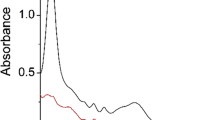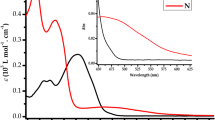Abstract
The two t-butylcalix[4]arene attached ruthenium(II)-bipyridine complexes (Rubc2 and Rubc3) has been synthesized and the anion recognition studies have been carried out using emission techniques. The binding of anions, which are sensed by the complexes, are studied by UV-visible and emission techniques. The complex Rubc2 recognizes the Cl−, H2PO4 − and AcO− anions. The complex Rubc3 recognizes the Br− and AcO− anions. The AcO− quenches the emission intensity of both two complexes but the other anion increases the emission intensity of the complexes. The excited state lifetime and transient absorption studies were carried out the AcO− facilitates non radiative pathway. The other anions stabilize the excited state and facilitate the radiative pathway.










Similar content being viewed by others
References
Duke RM, Veale EB, Pfeffer FM, Krugerc PE, Gunnlaugsson T (2010) Colorimetric and fluorescent anion sensors: an overview of recent developments in the use of 1,8-naphthalimide-based chemosensors. Chem Soc Rev 39:3936–3953
Martínez-Máñez R, Sancenón F (2003) Fluorogenic and chromogenic chemosensors and reagents for anions. Chem Rev 103:4419–4476
Beer PD, Gale PA (2001) Anion recognition and sensing: the state of the art and future perspectives. Angew Chem Int Ed 40:486–516
Li X, Wu Y-D, Yang D (2008) α-aminoxy acids: new possibilities from foldamers to anion receptors and channels. Acc Chem Res 41:1428–1438
Jentsch TJ, Stein V, Weinreich F, Zdebik AA (2002) Molecular structure and physiological function of chloride channels. Physiol Rev 82:503–568
Ashcroft FM (2000) Ion channels and disease. Academic, San Diego
Jentsch TJ, Hubner CA, Fuhrmann JC (2004) Ion channels: function unravelled by dysfunction. Nat Cell Biol 6:1039–1047
Zang L, Wei D, Wang S, Jiang S (2012) A phenolic Schiff base for highly selective sensing of fluoride and cyanide via different channels. Tetrahedron 68:636–641
Bhaumik C, Maity D, Das S, Baitalik S (2012) Synthesis, structural characterization, solvatochromism, and ion-binding studies of a ditopic receptor based on 2-(4-[2,2′:6′,2″]terpyridin-4′-yl-phenyl)-1H-phenanthro[9,10-d] imidazole (tpy-HImzphen) unit. RSC Adv 2:2581–2594
Kirk KL (1991) Biochemistry of the Halogens and Inorganic Halides. Plenum Press, New York
Hruska K, Teitlebaum S (1995) Renal osteodystrophy. New Engl J Med 333:166–175
Boivin G, Meunier PJ (2003) The mineralization of bone tissue: a forgotten dimension in osteoporosis research. Osteoporos Int 14:S19–S24
Zhu W, Huang X, Guo Z, Wu X, Yu H, Tian H (2012) A novel NIR fluorescent turn-on sensor for the detection of pyrophosphate anion in complete water system. Chem Commun 48:1784–1786
Kooijman SLAM (2000) Dynamic energy and mass budgets in biological systems, 2nd edn. Cambridge University Press, UK
Zhou XB, Chan WH, Lee AWM (2011) Ratiometric fluorescence sensor for detection of polyphosphate anions by sensor-ensemble method in aqueous solution. Tetrahedron Lett 52:5431–5434
Motomizu S, Li ZH (2005) Trace and ultratrace analysis methods for the determination of phosphorus by flow-injection techniques. Talanta 66:332–340
Harrison RM (1983) Pollution: causes effects and control. The Royal Society of Chemistry, London
Olszowy HA, Rossiter J, Hegarty J, Geoghegan P (1998) Background levels of bromide in human blood. J Anal Toxicol 22:225–230
Mayeno AN, Curran AJ, Roberts RL, Foote CS (1989) Eosinophils preferentially use bromide to generate halogenating agents. J Biol Chem 264:5660–5668
Olson KR (2003) Poisoning and Drug Overdose, 4th Ed, McGraw-Hill
Mahapatra AK, Roy J, Sahoo P, Mukhopadhyay SK, Chattopadhyay A (2012) Carbazole-thiosemicarbazone-Hg(II) ensemble-based colorimetric and fluorescence turn-on toward iodide in aqueous media and its application in live cell imaging. Org Biomol Chem 10:2231–2236
El-Balloulia AO, Zhang Y, Barlow S, Marder SR, Al-Sayah MH, Kaafarani BR (2012) Fluorescent detection of anions by dibenzophenazine-based sensors. Tetrahedron Lett 53:661–665
Gale PA, Garcia-Garrido SE, Garric J (2008) Anion receptors based on organic frameworks: highlights from 2005 and 2006. Chem Soc Rev 37:151–190
Caltagirone C, Gale PA (2009) Anion receptor chemistry: highlights from 2007. Chem Soc Rev 38:520–563
Gale PA, Quesada R (2006) Anion coordination and anion-templated assembly: highlights from 2002 to 2004. Coord Chem Rev 250:3219–3244
Amendola V, Esteban-Comez D, Fabbrizzi L, Licchelli M (2006) What anions do to N-H-containing receptors. Acc Chem Res 39:343–353
Juwarker H, Suk JM, Jeong KS (2010) Indoles and related heterocycles. Top Heterocycl Chem 24:177–204
Anzenbacher P Jr (2010) Pyrrole-based anion sensors, part II: fluorescence, luminescence, and electrochemical sensors. Top Heterocycl Chem 24:237–265
Bowman-James K (2005) Alfred Werner revisited: the coordination chemistry of anions. Acc Chem Res 38:671–678
Steed JW, Atwood JL (2000) Supramolecular chemistry. John Wiley & Sons, Ltd, New York
Muthu Mareeswaran P, Prakash M, Subramaniyan V, Rajagopal S (2012) Recognition of aromatic amino acids and proteins with I-sulfonatocalix[4]arene—a luminescence and theoretical approach. J Phys Org Chem 25:1217–1227
Muthu Mareeswaran P, Maheshwaran D, Babu E, Rajagopal S (2012) Binding and fluorescence resonance energy transfer (FRET) of ruthenium(II)-bipyridine-calixarene system with proteins—experimental and docking studies. J Fluoresc 22:1345–1356
Gutsche CD (2008) Calixarenes—An Introduction, 2nd Edition, RSC Publishing
Anzenbacher P Jr (2010) Pyrrole-based anion sensors, part I: colorimetric sensors. Top Heterocycl Chem 24:205–235
Beer PD, Drew MGB, Hazlewood C, Hesek D, Hodacova J, Stokes SE (1993) Dicarboxylate anion recognition by a redox-responsive ditopic bis(coba1ticinium)calix[4]arene receptor molecule. J Chem Soc Chem Commun 229–231
Danil de Namor AF, Shehab M (2004) Recognition of biologically and environmentally important phosphate anions by calix[4]pyrrole: thermodynamic aspects. J Phys Chem A 108:7324–7330
Danil de Namor AF, Shehab M, Abbas I, Withams MV, Zvietcovich Guerra J (2006) New insights on anion recognition by isomers of a calix pyrrole derivative. J Phys Chem B 110:12653–12659
Danil de Namor AF, Abbas I, Hammud HH (2007) A new calix[4]pyrrole derivative and its anion (fluoride)/cation (mercury and silver) recognition. J Phys Chem B 111:3098–3105
Danil de Namor AF, Abbas I, Hammud HH (2006) Anion complexation by calix[3]thieno[1]pyrrole: the medium effect. J Phys Chem B 110:2142–2149
Mandolini L (2000) Ungaro R calixarenes in action. Imperial College Press, London
Hamon M, Menand M, LeGac S, Luhmer M, Dalla V, Jabin I (2008) Calix[6]tris(thio)ureas: heteroditopic receptors for the cooperative binding of organic ion pairs. J Org Chem 73:7067–7071
Dinares I, Garcia de Miguel C, Mesquida N, Alcalde E (2009) Bis(imidazolium)-calix[4]arene receptors for anion binding. J Org Chem 74:482–485
Beer PD, Drew MGB, Nam KC (1997) A new carboxylate anion selective cobaltocenium calix[4]arene receptor. Chem Commun 107–108
Beer PD (2005) Anion sensing by metal-based receptors. Top Curr Chem 255:125–162
Sun SS, Lees AJ (2002) Transition metal based supramolecular systems: synthesis, photophysics, photochemistry and their potential applications as luminescent anion chemosensors. Coord Chem Rev 230:171–192
Fillaut JL, Andries J, Perruchon J, Desvergne JP, Toupet L, Fadel L, Zouchoune B, Saillard JY (2007) Alkynyl ruthenium colorimetric sensors: optimizing the selectivity toward fluoride anion. Inorg Chem 46:5922–5932
Kalyanasundaram K (1992) Photochemistry of polypyridine and phorphyrin compelxes. Academic Press Ltd, London
Mishra A, Vajpayee V, Kim H, Lee MH, Jung H, Wang M, Stang PJ, Chi KW (2012) Self-assembled metalla-bowls for selective sensing of multi-carboxylate anions. Dalton Trans 41:1195–1201
Elmes RBP, Gunnlaugsson T (2010) Luminescence anion sensing via modulation of MLCT emission from a naphthalimide-Ru(II)-polypyridyl complex. Tetrahedron Lett 51:4082–4087
Beer PD (1998) Transition-metal receptor systems for the selective recognition and sensing of anionic guest species. Acc Chem Res 31:71–80
Kitchen JA, Boyle EM, Gunnlaugsson T (2012) Synthesis, structural characterisation and luminescent anion sensing studies of a Ru(II)polypyridyl complex featuring an aryl urea derivatised 2,2′-bpy auxiliary ligand. Inorg Chim Acta 381:236–242
Beer PD, Cadman J (1999) Phosphate anion binding and luminescent sensing in aqueous solution by ruthenium(II) bipyridyl polyaza receptors. New J Chem 23:347–349
Kim JS, Quang DT (2007) Calixarene-derived fluorescent probes. Chem Rev 107:3780–3799
Szemes F, Hesek D, Chen Z, Dent SW, Drew MGB, Goulden AJ, Graydon AR, Grieve A, Mortimer RJ, Wear T, Weightman JS, Beer PD (1996) Synthesis and characterization of novel acyclic, macrocyclic, and calix[4]arene ruthenium(II) bipyridyl receptor molecules that recognize and sense anions. Inorg Chem 35:5868–5879
Rajkumar E, Rajagopal S (2008) Photoinduced electron transfer reaction of tris(4,4¢-dicarboxyl-2,2¢-bipyridine)ruthenium(II) ion with organic sulfides. Photochem Photobiol Sci 7:1407–1414
Swarnalatha K, Rajkumar E, Rajagopal S, Ramaraj R, Lu YL, Lu KL, Ramamurthy P (2005) Photoinduced electron transfer reactions of ruthenium(II) complexes containing 2,2′-bipyridine-4,4′-dicarboxylic acid with phenols-Steric and charge effects. J Photochem Photobiol A Chem 171:83–90
Rajkumar E, Rajagopal S, Ramamurthy P, Vairamani M (2009) Photophysics of ruthenium(II) complexes carrying amino acids in the ligand 2,2′-bipyridine and intramolecular electron transfer from methionine to photogenerated Ru(III). Inorg Chim Acta 362:1629–1636
Haider JM, Chavarot M, Weidner S, Sadler I, Williams RM, De Cola L, Pikramenou Z (2001) Metallocyclodextrins as building blocks in noncovalent assemblies of photoactive units for the study of photoinduced intercomponent processes. Inorg Chem 40:3912–3921
Harriman A, Hissler M, Jost P, Wipff G, Ziessel R (1999) Conformational control of intramolecular electron transfer in calix[4]diquinones and their cationic complexes. J Am Chem Soc 121:14–27
Connors KA (1987) Binding constants: the measurement of stability. John Wiley & Sons, Ltd, Chichester
Upadhyay SP, Pissurlenkar RRS, Coutinho EC, Karnik AV (2007) Furo-fused BINOL based Ccrown as a fluorescent chiral sensor for enantioselective recognition of phenylethylamine and ethyl Eester of valine. J Org Chem 72:5709–5714
Lakowicz JR (2006) Principles of fluorescence spectroscopy, 3rd edn. Kluwer Academic press, New York
Miedlar K, Das PK (1982) Tris(2,2′-bipyridine)ruthenium(II)-sensitized photooxidation of phenols. Environmental effects on electron transfer yields and kinetics. J Am Chem Soc 104:7462–7469
Acknowledgement
We sincerely thank Prof. P. Ramamurthy, National Center for Ultrafast Process, University of Madras, Taramani, Chennai for his help in time resolved measurements. We sincerely thank Dr. Vairamani, IICT, Hyderabad for his help in HR-MS. We thank UGC-UPE for financial support.
Author information
Authors and Affiliations
Corresponding author
Electronic supplementary material
Below is the link to the electronic supplementary material.
ESM 1
(DOCX 1247 kb)
Rights and permissions
About this article
Cite this article
Muthu Mareeswaran, P., Babu, E. & Rajagopal, S. Optical Recognition of Anions by Ruthenium(II)-Bipyridine-Calix[4]Arene System. J Fluoresc 23, 997–1006 (2013). https://doi.org/10.1007/s10895-013-1226-6
Received:
Accepted:
Published:
Issue Date:
DOI: https://doi.org/10.1007/s10895-013-1226-6




